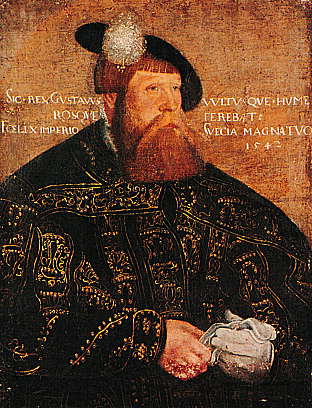|
Blot-Sweyn
Blot-Sweyn (Swedish:''Blot-Sven'') was a Swedish king c. 1080, who replaced his Christian brother-in-law Inge as King of Sweden, when Inge had refused to administer the blóts (pagan sacrifices) at the Temple at Uppsala. There is no mention of Sweyn in the regnal list of the '' Westrogothic law'', which suggests that his rule did not reach Västergötland. According to Swedish historian Adolf Schück he was probably the same person as Håkan the Red and was called the ''Blót Swain'' (a ''swain'' who was willing to perform the blót) as an epithet rather than a personal name. Becoming king The earliest source that deals with Blot-Sweyn's coming to power is the Icelandic legendary saga '' Hervarar saga'': However, Inge did not permit the people to follow the old ways, unlike his father Stenkil. The Swedes reacted strongly and asked Inge to either comply with the old traditions or abdicate. When Inge proclaimed that he would not abandon Christianity, the people pelted him with s ... [...More Info...] [...Related Items...] OR: [Wikipedia] [Google] [Baidu] |
Inge I Of Sweden
Inge the Elder (Swedish: ''Inge Stenkilsson''; Old Norse: ''Ingi Steinkelsson''; died c. 1105–1110) was a king of Sweden. In English literature he has also been called ''Ingold''. While scant sources do not allow us to paint a full picture of his term of kingship, he is known to have led a turbulent but at length successful reign of more than two decades. He stands out as a devout Christian who founded the first abbey in Sweden and acted harshly against pagan practices. The kingdom was still an unstable realm based on alliances of noblemen, and Inge's main power base was in Västergötland and Östergötland; one of the earliest chronicles that mention his reign knows him as ''rex gautorum'', king of the Geats.Peter Sawyer, ''När Sverige blev Sverige''. Alingsås: Viktoria, 1991, p. 37. Biography Inge was the son of the former King Stenkil and a Swedish princess. Inge shared the rule of the kingdom with his probably elder brother Halsten Stenkilsson,< ... [...More Info...] [...Related Items...] OR: [Wikipedia] [Google] [Baidu] |
Håkan The Red
Håkan the Red (Swedish: ''Håkan Röde'') was a king of Sweden, reigning for about half a decade in the second half of the 11th century.''Håkan Röde'' in ''Nationalencyklopedin'': There is little information on him, and it is mostly contradictory. Nothing is known about his reign."Håkan" article in '''' (1910): Swedish historian Adolf Schück has asserted that, rather than '''' being an individual king, there are indications that that may have been an |
Saint Eskil
Saint Eskil (11th century) was an Anglo-Saxon monk particularly venerated during the end of the 11th century in the province of Södermanland, Sweden. He was the founder of the first diocese of the lands surrounding Lake Mälaren, today the Diocese of Strängnäs. He is the patron saint of Södermanland and the Diocese of Strängnäs. Life Saint Eskil was sent as a missionary bishop to the Lake Mälaren area by Saint Sigfrid of Växjö along with Saint Botvid and Saint David. Botvid lies buried in Botkyrka, today a suburb of Stockholm in the east of Södermanland. All three saints are known to have perished trying to Christianize the people living around Lake Mälaren and both Eskil and Botvid have been made patron saints of Södermanland County. David has been made patron saint of Västerås and the province of Västmanland. They all are sources of several medieval legends. Eskil probably lived during the reign of King Inge the Elder at the end of the 11th century. Alban ... [...More Info...] [...Related Items...] OR: [Wikipedia] [Google] [Baidu] |
Quickfire
Arson in medieval Scandinavia ( Old Norse ''hús-brenna ''or ''hús-bruni, ''"house-burning") was a technique sometimes employed in blood feuds and political conflicts in order to assassinate someone. In committing arson, a group of attackers would set fire to the home of an opponent, sometimes by quickly and surreptitiously piling wood, brush and other combustible materials against the exterior of a dwelling and set it on fire. Typically the attackers would surround the house to prevent the escape of its inhabitants, although women, the elderly, and small children were sometimes allowed to leave.''Njal's Saga'' § 129. In Iceland Under Icelandic law as codified in the Gragas, quickfire could be punished by death only if the arsonists were killed in the act. However, if captured alive the arsonists had to be tried and sentenced to outlawry, even if they were '' thralls''. Failure to observe these formalities could result in the killer of quickfire-arsonists being prosecuted hi ... [...More Info...] [...Related Items...] OR: [Wikipedia] [Google] [Baidu] |
Sacred Tree At Uppsala
The sacred tree at Uppsala was a sacred tree located at the Temple at Uppsala, Sweden, in the second half of the 11th century. It is not known what species it was. Older sources have described it as an ash tree, but have suggested that it was a yew tree. It is even more sparsely documented than the famous temple by which it stood. In the 1070s, the writer of a scholium in Adam of Bremen's '' Gesta Hammaburgensis ecclesiae pontificum'' explained: Near that temple is a very large tree with widespread branches which are always green both in winter and summer. What kind of tree it is nobody knows. There is also a spring there where the pagan are accustomed to perform sacrifices and to immerse a human being alive. As long as his body is not found, the request of the people will be fulfilled. The description of the tree and the location of a well nearby are reminiscent of the evergreen Yggdrasil, which stood above the Well of Urd, and it is possible that the Swedes consciously h ... [...More Info...] [...Related Items...] OR: [Wikipedia] [Google] [Baidu] |
King Of Sweden
The monarchy of Sweden is the monarchical head of state of Sweden,See the #IOG, Instrument of Government, Chapter 1, Article 5. which is a constitutional monarchy, constitutional and hereditary monarchy with a parliamentary system.Parliamentary system: see the #IOG, Instrument of Government, Chapter 1, Article 1. There have been kings in what now is the Sweden, Kingdom of Sweden for more than a millennium. Originally an elective monarchy, it became a hereditary monarchy in the 16th century during the reign of Gustav Vasa, though virtually all monarchs before that belonged to a limited and small number of families which are considered to be the royal dynasties of Sweden. Sweden in the present day is a representative democracy in a parliamentary system based on popular sovereignty, as defined in the current Basic Laws of Sweden#Instrument of Government, Instrument of Government (one of the four Basic Laws of Sweden, Fundamental Laws of the Realm which makes up the written constitu ... [...More Info...] [...Related Items...] OR: [Wikipedia] [Google] [Baidu] |
Horse Sacrifice
Horse sacrifice is the ritual killing and offering of a horse, usually as part of a religious or cultural ritual. Horse sacrifices were common throughout Eurasia with the domestication of the horse and continuing up until the spread of Abrahamic religions, or in some places like Mongolia, of Buddhism. The practice is rarely observed in some cultures even today. Many ethnic religions from Indo-European speaking peoples show evidence for horse sacrifice, and comparative mythology suggests that they derive from a purported Proto-Indo-European ritual and common root, though the practice is also observed among non-Indo-European speaking peoples, especially in nomadic societies from the Eurasian steppe. Context Horses are often sacrificed in a funerary context, and interred with the deceased, a practice called horse burial. There is evidence but no explicit myths from the three branches of Indo-Europeans of a major horse sacrifice ritual based on a speculated mythical union of Ind ... [...More Info...] [...Related Items...] OR: [Wikipedia] [Google] [Baidu] |
Strängnäs
Strängnäs is a locality and the seat of Strängnäs Municipality, Södermanland County, Sweden with 15,363 inhabitants in 2020. It is located by Lake Mälaren and is the episcopal see of the Diocese of Strängnäs, one of the thirteen dioceses of the Church of Sweden. Prominently located on a hilltop, Strängnäs Cathedral, built between 1291 and 1340, is an important landmark. Etymology The city's name is first encountered in 1120, in reference to the Diocese. The name Strängnäs is derived from the fact that the city is located near a strait and on several hills, especially on two major ones, the "Mill Hill" and the "Cathedral Hill". In Old Norse ''strengr'' indicates a "narrow channel of water" and ''nes'' refers to an " isthmus", "narrow peninsula", or " headland", a very common toponymic in Scandinavia. History A monastery was established around 1250, and the cathedral inaugurated in 1291, with the town subsequently evolving around these two institutions. The oldest ... [...More Info...] [...Related Items...] OR: [Wikipedia] [Google] [Baidu] |
Church Of Sweden
The Church of Sweden ( sv, Svenska kyrkan) is an Evangelical Lutheran national church in Sweden. A former state church, headquartered in Uppsala, with around 5.6 million members at year end 2021, it is the largest Christian denomination in Sweden, the largest Lutheran denomination in Europe and the third-largest in the world, after the Ethiopian Evangelical Church Mekane Yesus and the Evangelical Lutheran Church in Tanzania. A member of the Porvoo Communion, the church professes Lutheranism. It is composed of thirteen dioceses, divided into parishes. It is an open national church which, working with a democratic organisation and through the ministry of the church, covers the whole nation. The Primate of the Church of Sweden, as well as the Metropolitan of all Sweden, is the Archbishop of Uppsala. Today, the Church of Sweden is an Evangelical Lutheran church. It is liturgically and theologically " high church", having retained priests, vestments, and the Mass during t ... [...More Info...] [...Related Items...] OR: [Wikipedia] [Google] [Baidu] |
U 861, Norsta
U or u, is the twenty-first and sixth-to-last letter and fifth vowel letter of the Latin alphabet, used in the modern English alphabet, the alphabets of other western European languages and others worldwide. Its name in English is ''u'' (pronounced ), plural ''ues''. History U derives from the Semitic waw, as does F, and later, Y, W, and V. Its oldest ancestor goes to Egyptian hieroglyphics, and is probably from a hieroglyph of a mace or fowl, representing the sound Voiced_labiodental_fricative.html" ;"title="nowiki/> vor the sound [Voiced labial–velar approximant">w">Voiced labiodental fricative">vor the sound [Voiced labial–velar approximant">w This was borrowed to Phoenician, where it represented the sound [w], and seldom the vowel [Close back rounded vowel, u]. In Greek language, Greek, two letters were adapted from the Phoenician waw. The letter was adapted, but split in two, with the Digamma, first one of the same name (Ϝ) being adapted to represent w">n ... [...More Info...] [...Related Items...] OR: [Wikipedia] [Google] [Baidu] |
Adam Of Bremen
Adam of Bremen ( la, Adamus Bremensis; german: Adam von Bremen) (before 1050 – 12 October 1081/1085) was a German medieval chronicler. He lived and worked in the second half of the eleventh century. Adam is most famous for his chronicle '' Gesta Hammaburgensis ecclesiae pontificum'' (''Deeds of Bishops of the Hamburg Church''). He was "one of the foremost historians and early ethnographers of the medieval period". In his chronicle, he included a chapter mentioning the Norse outpost of Vinland, and was thus the first European to write about the New World. Life Little is known of his life other than hints from his own chronicles. He is believed to have come from Meissen, then its own margravate. The dates of his birth and death are uncertain, but he was probably born before 1050 and died on 12 October of an unknown year (possibly 1081, at the latest 1085). From his chronicles, it is apparent that he was familiar with a number of authors. The honorary name of ''Magister Adam'' ... [...More Info...] [...Related Items...] OR: [Wikipedia] [Google] [Baidu] |






